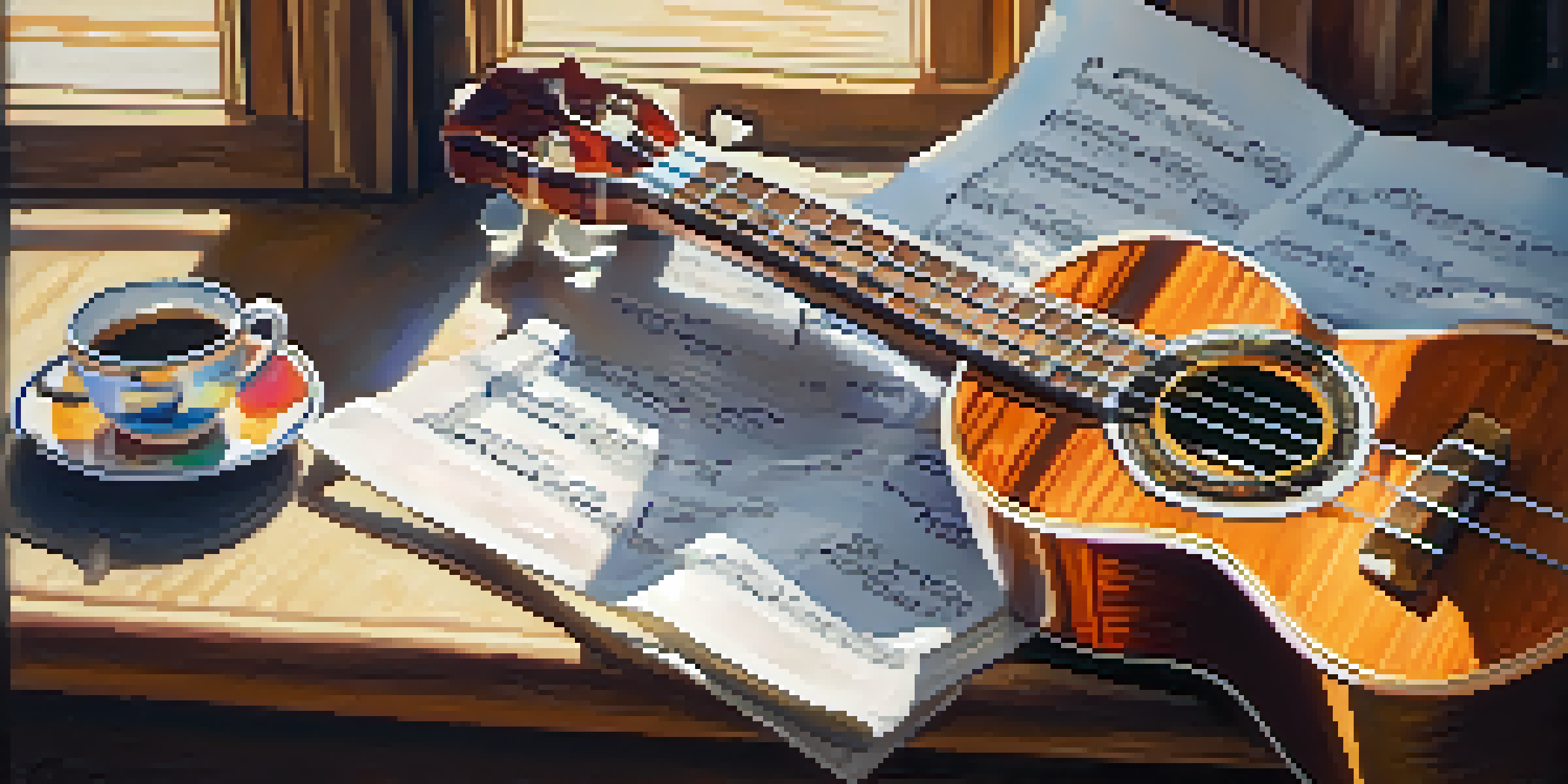Essential Improvisation Techniques for Ukulele Beginners

Understanding the Basics of Ukulele Improvisation
Improvisation on the ukulele is all about spontaneity and creativity. At its core, it allows you to express yourself musically without relying solely on written music. Think of it as having a conversation; instead of reading from a script, you’re responding to your musical thoughts in real-time.
Improvisation is the ability to make a mistake and have it become part of the performance.
One essential aspect of improvisation is familiarity with the instrument. Spend time getting to know your ukulele—its sounds, its frets, and how different chords resonate. The more comfortable you are with your instrument, the easier it will be to navigate your musical ideas.
Finally, improvisation isn't just about playing notes; it's about feeling and emotion. Allow yourself to play what you feel in the moment, and don’t be afraid to make mistakes. After all, some of the best musical moments come from unexpected turns.
Mastering Basic Chords for Effective Improvisation
To improvise effectively, you need a solid foundation of basic chords. Start with the common major and minor chords like C, G, Am, and F. These chords are the building blocks for many songs, and knowing them will give you the freedom to explore your musical ideas.

Once you have these chords down, practice transitioning between them smoothly. This fluidity will allow you to focus more on your improvisation rather than getting stuck on chord changes. Try playing along with songs you love to see how these chords fit into a larger context.
Embrace Spontaneity in Playing
Improvisation on the ukulele encourages musical expression through spontaneous creativity, much like having a conversation.
As you grow more comfortable, start experimenting with different strumming patterns and rhythms. This can drastically change the mood of your improvisation and help you find your unique style. Remember, the goal is to express yourself, so let your creativity shine!
Exploring Scales for Melodic Improvisation
Scales are crucial for crafting melodies during improvisation. The major scale is a great starting point, as it consists of seven notes that create a bright, uplifting sound. Familiarity with this scale will enable you to create melodies that fit well over the chords you're playing.
Music is the shorthand of emotion.
Another useful scale is the pentatonic scale, which has five notes and is widely used in various music genres. It’s simpler and often sounds great over many chord progressions, making it an ideal tool for beginners. Practice this scale until you can play it effortlessly, as it will open up new melodic possibilities.
Integrating scales into your practice can be as simple as playing along with backing tracks. This gives you the opportunity to experiment with different notes and discover which ones resonate with you. The more you play, the more confident you’ll become in your ability to improvise.
Using Rhythm to Enhance Your Improvisation
Rhythm is the heartbeat of music, and mastering it can elevate your improvisation. Start by clapping out different rhythms to get a feel for timing and syncopation. This will help you become more aware of how rhythm interacts with melody and harmony.
When you begin improvising, don’t just focus on the notes; pay attention to how you play them. Experiment with playing notes longer or shorter, or adding rests in between to create tension and release. This can add a dynamic quality to your improvisation that keeps listeners engaged.
Master Chords for Freedom
A solid grasp of basic chords like C, G, Am, and F provides the foundation needed to explore and express your musical ideas.
Listening to various styles of music can also inspire your rhythmic choices. Whether it’s jazz, folk, or pop, each genre has its unique rhythm patterns. Incorporating diverse rhythms will not only enrich your playing but also help you develop your personal style.
Incorporating Variations in Your Playing
Variations are essential for keeping your improvisation fresh and exciting. Instead of playing the same melody repeatedly, try altering it slightly each time. This could be changing the order of notes, adjusting the rhythm, or even adding embellishments to spice things up.
A simple way to implement variations is through dynamics—playing some parts softly and others loudly. This contrast can create an emotional journey for your listeners, drawing them into your improvisation. It’s like telling a story where the climax hits harder due to the quieter build-up.
Don’t shy away from experimenting with different techniques as well. Try hammer-ons, pull-offs, or slides to add flair to your playing. These little touches can make a big difference in how engaging your improvisation feels.
Listening and Learning from Other Musicians
One of the best ways to improve your improvisation skills is by listening to other musicians. Pay attention to how they approach improvisation and what techniques they use. This can provide you with a wealth of ideas and inspiration for your own playing.
YouTube and various music streaming platforms are treasure troves of performances. Watching live sessions can show you how musicians interact and build upon each other's ideas. Take notes on what you find appealing and try incorporating those elements into your own improvisation.
Regular Practice Enhances Skills
Consistent practice is crucial for developing improvisation skills, allowing you to reinforce learning and grow more confident over time.
Joining a ukulele group or community can also enhance your learning experience. Playing with others not only helps you practice but also exposes you to different styles and techniques. Collaborating with fellow musicians can spark new ideas and foster a supportive environment for growth.
Practicing Regularly for Continuous Improvement
Consistency is key when it comes to developing your improvisation skills. Set aside time each day to practice, even if it’s just for a few minutes. This regular engagement will help reinforce what you’ve learned and make you more comfortable with improvisation.
During practice, focus on specific aspects of improvisation, such as scales, chords, or rhythm. You might dedicate one day to working on melodies and another to experimenting with variations. This focused approach will ensure you’re making progress in different areas.

Lastly, don’t forget to have fun! The ukulele is a joyful instrument, and improvisation should feel liberating and exciting. Celebrate your progress and embrace the journey, knowing that every practice session brings you closer to becoming a more confident improviser.